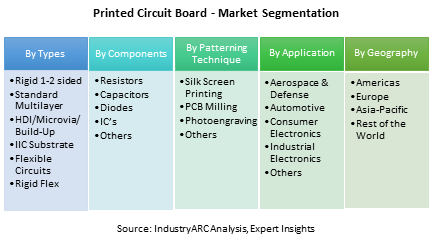The global Printed Circuit Board Market is estimated to reach $70 billion by 2024 growing at an estimated CAGR 2.5% during 2018 to 2024. Globally demand for Printed Circuit Board is expected to be driven by increase in the demand for advanced consumer electronics and smart devices, growing automation in industries, and technologically advanced health care devices. China is set to dominate the global PCB market with a value of share of 41% in 2017 and is projected to grow with highest CAGR of 3.2% during the forecast period 2018-2024. Industrial electronics held the major revenue in 2017 for PCB market with $ 23.3 billion in 2017 and is projected to grow with a CAGR of 2.7% during the forecast period.

- HDI(High Density Interconnect PCBs), one of the most promising growing technologies in PCBs, as they have a higher circuitry density than traditional circuit boards and also comprises of blind and/or buried vias and often contain microvias of .006 or less in diameter. By utilizing HDI technology, designers have multiple options to place one or more components on both sides of the raw PCB. Decreased component size and pitch allow for more I/O in smaller geometries allows faster transmission of signals and also results in significant reduction of signal loss and crossing delays.
- PCB Design tools in the past had isolated functional modules for Schematic Capture, PCB Layout, Signal Analysis, Thermal Analysis and Computer Aided Manufacturing. But today all these functionalities have been merged onto a single platform as system based design becomes evident.
- The traditional form of system development deals with PCB designing separately but the current aspects focus on an integrated approach. While PCB Design tools do not offer much growth potential but are directly correlated with the emergence of System Design Automation. PCB links the electronic and mechanical design of products which can be utilized for value creation for customers. Even if the market in itself does not provide high-growth opportunities, the up surge in challenges including wire harness design and package designs, the importance of PCB tools is going to become significant.
- The Internet of things (IoT) is providing new opportunities to the consumer electronics manufacturers. The amount of systems connected over internet has been expanded over the past decade. Wearable devices such as smart watches have witnessed tremendous growth. Wearable Devices incorporates flexible sensors and chips for comfortably confining into human body. This requires breakthrough designing and manufacturing technology, which will have great impact on the PCB market.
- Evaluate market potential through analyzing growth rates (CAGR %), Volume (Units) and Value ($M) data given at country level – for product types, end use applications and by different industry verticals.
- Understand the different dynamics influencing the market – key driving factors, challenges and hidden opportunities.
- Get in-depth insights on your competitor performance – market shares, strategies, financial benchmarking, product benchmarking, SWOT and more.
- Analyze the sales and distribution channels across key geographies to improve top-line revenues.
- Understand the industry supply chain with a deep-dive on the value augmentation at each step, in order to optimize value and bring efficiencies in your processes.
- Get a quick outlook on the market entropy – M&A’s, deals, partnerships, product launches of all key players for the past 4 years.
- Evaluate the supply-demand gaps, import-export statistics and regulatory landscape for more than top 20 countries globally for the market.
"We also publish more than 100 reports every month in “Electronics”, Go through the Domain if there are any other areas for which you would like to get a market research study."










Comments (0)
Post a Comment